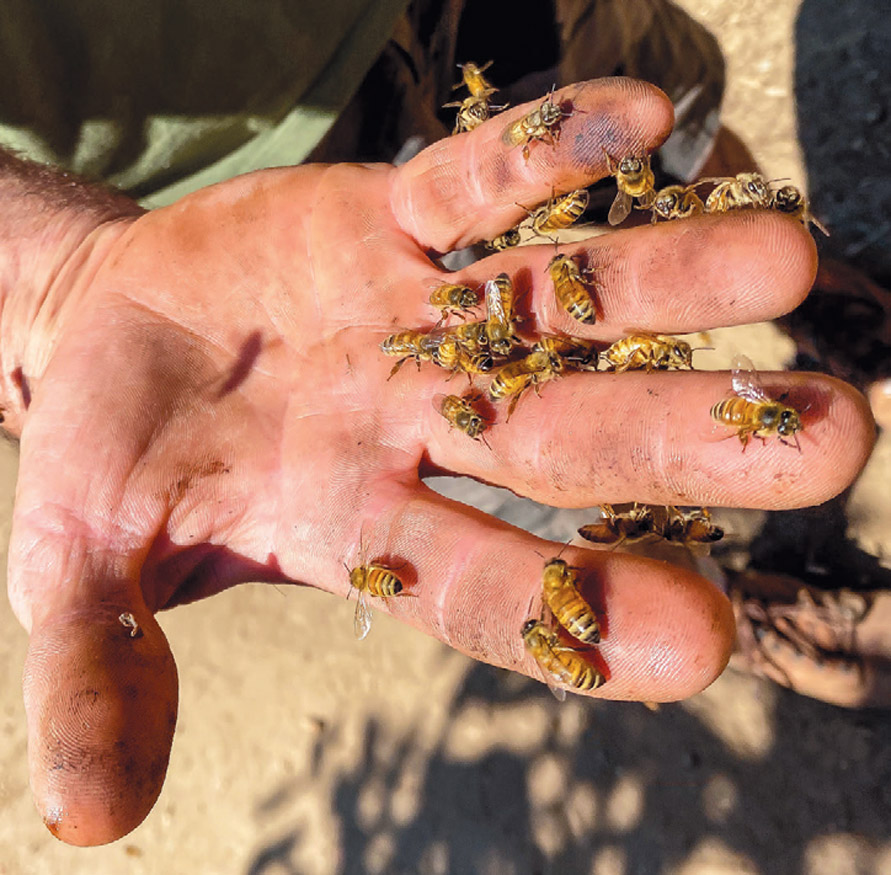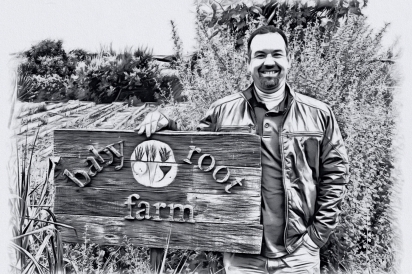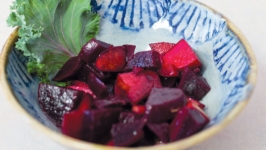It's a Fiery World
David and Wendi Mitchell
SANTA PAULA
Founders and owners, Blue Ridge Honey
A lot has changed since David Mitchell piled three beehives into his mom’s Mazda 808 station wagon and drove to Santa Paula in 1973. “Back then,” David recalls, “when there was citrus around and plenty of water, there were probably six beekeepers in Santa Paula, and another seven or eight in Fillmore.”
Throughout a typical year, the Mitchells move their hives around locally to pollinate different crops and native species: almonds in February, oranges and avocados in March, cauliflower in April, sage in the mountain hills in May and, finally, wildflower and buckwheat in the summer months. “There have been good years and bad years,” Wendi says. “Honey has its ups and downs.”
David remembers, “In the ’80s we had a bad drought, but we still had storage water.” Even the 2017 Thomas Fire was not as devastating for their bees as it could have been because their sons were able to move most of the hives in time. Wendi says, “Since the beginning, we’ve always had some honey produced to sell each year.” Until now. “This is the first year we’ve had no new honey.”
There’s a messy mix of environmental, political and economic factors contributing to the honey production decline in Ventura County. Namely, an unprecedented drought that has drastically reduced the number of native plants available to pollinate; an increase in the climate-change-related “Deformed Wing Virus” currently devastating bee populations world-wide; pesticide use; water restrictions on vital bee-pollinated crops like almonds; and the exorbitant costs associated with shipping bees to other parts of the country for part of the year in order to remain profitable.
Understandably, the Mitchells are frustrated. According to the U.S. Department of Agriculture, pollinators, most often honey bees, are responsible for one in every three bites of food we take, and increase our nation’s crop values each year by more than $15 billion. Despite the obvious importance of bees to our food supply, David laments how beekeepers do not receive subsidies in a “bad year” like some more lucrative farmers, and how almond farmers he works with in California’s Central Valley, essential to his honey bee production, are being forced to let 30–40% of their fields fallow. “There are almost no beekeepers left in Ventura County,” Wendi says. David adds, “It’s almost as if the state wishes agriculture would go away.”
Notwithstanding the extreme obstacles, the Mitchells remain hopeful. “I was just stalked by a guy in Bakersfield for my honey. He made me pull my truck over: ‘Do you have sage [honey]?’ he demanded. He wanted premium table honey. He knew I had the best. Ventura County honey is the best.” The Mitchells plan to keep their Ventura County bee operation viable by staying flexible with their business. In the meantime, we can hope for rain so that we can stalk David’s truck for premium Blue Ridge Honey next year.
Jim Churchill
OJAI
Founder and Owner, Churchill Orchards, Tangerine Man
“It’s all contingent on rain,” says Jim Churchill matter-of-factly. He’s not just referring to his 12 acres of tangerines and three acres of avocados, but also to his ability to live simply in Ojai. When Jim washes his dishes, he runs the water into a small bucket until it’s hot, then he uses this gray water in his garden. “I do what I can.”
Jim’s conservation ethic is mirrored in his business practices: He scours his irrigation lines regularly for potential leaks and blockages, uses an atmometer to measure the need to irrigate precisely and pays close attention to his soil’s health, “adding more mulch than you would believe possible” to minimize water use and to build healthy soil. Despite his painstaking efforts, Jim has been forced to increase his irrigation due to record-breaking drought conditions. “This was the first year I had to pay a $5,000 penalty for exceeding my allotment. I had to make a choice: lose my crops, or pay the fine.”
Jim is well aware of the scientific data revealing that the drought is making his livelihood unsustainable. He cites the work of Daniel Swain at UCLA and compelling evidence that California’s already-narrow wet season is becoming even shorter and sharper. Moreover, Jim has to contend with a new pest, the Asian Citrus Psyllid, which carries a disease fatal to citrus trees if not treated with expensive pesticides approved for organic produce. Climate change has affected the growth, development, metabolic rate, survival, propagation, migration and diffusion of pests like the Asian Citrus Psyllid, and the boundary of the pathogen it transmits has also shifted signifi- cantly northward to citrus trees in California in response to climate change.
Given the obstacles to his livelihood, Jim is taking things one season at a time. He’s expecting Casitas Water District to impose restrictions on agricultural water use. He’s expecting water prices to increase. He’s expecting to take some of his trees out of production.
“I don’t want to live anywhere else… but I don’t know.”
After speaking with Jim, I walk around my Ojai neighborhood to wrap my head around his situation and the future of farming more generally. I pass a few lush green lawns and wonder, “Can we all just wash our dishes like Jim?”
Chris Sayer
SATICOY
Manager and Partner, Petty Ranch
Chris Sayer is a prime example of an adaptable, hardworking Ventura County farmer, always poised to take on new challenges. His family has been farming in the area since the 1880s, so perhaps it’s in his familia roots to understand how to confront farming obstacles and shift what he farms, and how he farms, as necessary.
“My family started out growing lima beans, walnuts and oranges. Most of this century we grew lemons because those were popular. In 1954, we started growing avocados, but it was still mostly lemons. However, by early 2000 the lemon trees were old and land was tired; the trees just weren’t producing. In 2008 we started transitioning to 60% avocados and 40% lemons.” According to Chris, avocados are more popular and more lucrative, and easier to grow—so he made the change and business is thriving.
Of course, enabling anything to thrive in a record-breaking drought, including avocados, still requires some nimble foresight. “Water quality has decreased. Salination is a big problem for salt-sensitive avos.” Chris has installed soil sensors to measure salinity and moisture so that he waters just what the plants need. He’s planted younger trees on a third of his acreage because they have a higher chance of surviving the drought. He’s learned to harvest a bit earlier and aggressively prune to increase production. He rotates crops, diversifies crops, uses integrated pest management and, perhaps most importantly, continually builds up a robust soil that is truly regenerative. “As a kid, I was responsible for cleaning the drains. Three inches or more of rainfall would cause the drainage area to back up and flood. Now, it takes about five inches of rainfall to back up those same drains; it doesn’t flood as usual. This is wonderful validation that my soils save two inches of rain.”
At this point, Chris’s biggest climate change worry isn’t running out of water (although he “never takes it for granted”), it’s temperature. At temperatures above 100°F, avocados lose more moisture through their leaves than they can take up through their roots. “We are betting our future on avocados, but if we get 115–120° days on a regular basis, all bets are off.” What then? “Figs can handle those temps.” Chris, and perhaps other local farmers, will adapt.
Phil McGrath & Mike Roberts
CAMARILLO
McGrath Family Farm Collective
There’s no better person to talk about how climate change has affected Ventura County farming than Phil McGrath—a trying-to-retire fourth-generation Oxnard farmer passionate about sustainability. “Up until the 1980s, we had an average amount of rain yearly. By the 1990s, rain started falling erratically. Rain would come all at once and the rest of the year would be dry, but we were able to keep our water averages. In 2007, that’s when things changed.” The change: drought. As of today, his well pumped 25% of what it pumped 10 years ago. “This year was the driest year ever.”
According to Mike Roberts, one of the farmers on the McGrath property, “Phil is always on site, and water is a huge focus for him, the most critical issue on the farm.” Mike grows mini-sized roots, shoots, fruits and lots of California native plants on a plot that’s part of the larger McGrath Family Farms Collective.
To further mitigate the farm’s impact on the environment, they utilize alternative energy and only transport food within a 100-mile radius to reduce carbon emissions. To address issues around healthy food and social equity, they have partnerships with Food Forward and Food Share and are developing their own mutual aid programs to make their produce available to people who can’t afford it. Mike shares his knowledge as much as possible to the public, and tries to “get people on the farm by any means necessary, from weddings to workshops, to get connected with the food they’re consuming.” Education and action are the keystones of this regenerative farming operation, and addressing climate change more generally.
Is it working? “Tracking the data is a long game,” admits Mike, “but there are positive changes, and biodiversity on the farm is growing.” Mike remains hopeful that his regenerative farming practices will improve the soil, and through education and thoughtful science-based programming, the larger community and climate change mitigation efforts.
 I told Mike he’s the most positive farmer I’ve spoken to, and that I admired not just the work he’s doing, but also his high spirits in the face of adversity. He laughs, “If I embraced reality, I wouldn’t get out of bed.”
I told Mike he’s the most positive farmer I’ve spoken to, and that I admired not just the work he’s doing, but also his high spirits in the face of adversity. He laughs, “If I embraced reality, I wouldn’t get out of bed.”
Phil, the realist (except for retirement), does not sugarcoat what needs to be done: We must grow foods in their seasons; they use less inputs, especially water. Fire is inevitable, so plant fire walls, like agave plants, around citrus orchards. Stop exporting everything you grow: “We tax the environment so much growing things out of season and shipping our produce all over the world. It is equivalent to exporting our water!” The demand needs to shift: buy local, buy organic, buy in-season. Instead of buying with your eyes and pocketbook, buy with your nose, touch and for flavor. And so on.
Evidently, it’s difficult to retire when you are striving to leave the land a better place than you found it.














